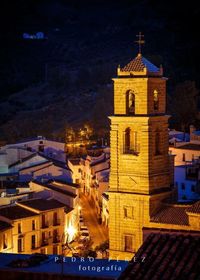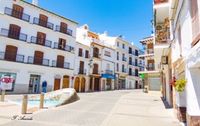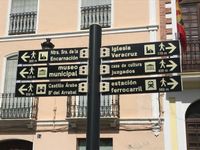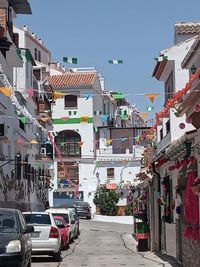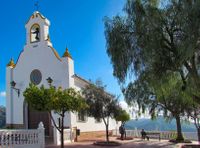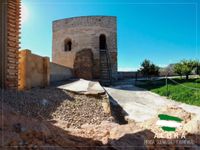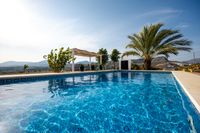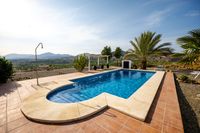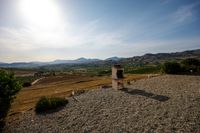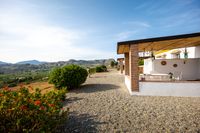Álora
Álora, our new home. We call it; the Spanish Wierden (where we lived in the Netherlands). Álora is built on 3 mountains, which is a beautiful sight when you arrive. It has a unique Andalusian look with its steep streets and white houses. The inhabitants called "Perotes" are friendly and very hospitable. Álora has the second oldest church in Spain and the oldest in Andalucia, with a beautiful square and views over the valley. From the castle on top of the mountain it is an even more beautiful view over the surroundings of Álora. You can have a delicious meal in one of the many restaurants on one of the many squares. Possibility of beautiful walks in and around Álora. It is centrally located in Andalusia.
Region: Guadalhorce Valley
Population: 13,204 inhabitants
Altitude: 222 metres
Physical area: 169 km2
Population: Aloreño/a
Description
Álora is a city in the state of Andalusia and in the province of Malaga. Its surface area is 169 km² and it has a density of 78.13 inhabitants/km². Its geographical coordinates are 36º49′ N, 4º 42′ W.
It is located at an altitude of 222 metres and 41 kilometres from the provincial capital of Malaga.
Geographical location:
Álora is located between 3 hills on the right bank of the Guadalhorce River and next to the railway line connecting Malaga with Seville, Cordoba or Granada.
The municipal district extends over a large area in which the great formations of the Malaga relief can be found. North of the Arco Calizo Central (the Antequera mountain range) offers spectacular landscapes, and in the Sierra de Huma (1,191 m) and in the Desfiladero de los Gaitanes (shared with the neighbouring municipalities of Antequera and Árdales).
To the west of the Sierra de Aguas (949 m above sea level), the mountainous complex of the Serranía de Ronda extends into these areas and offers a landscape of pine forests that stretches from the River Guadalhorce to the road that links Álora with Carratraca.
East of the Guadalhorce River, the landscape is gentle in shape with small hills occupied by cereals, some olive trees and remnants of the ancient holm oak; it is the landscape of the natural corridor that the province from Periana to Alora and separates the Antequera mountains from the Málaga mountains. Mountains that also stand out in Álora in the western half of the year with its characteristic labyrinthine hilly landscape, mainly covered with olive groves, almond trees and scrubland.
Culture
Museo de Álora Rafael Lería: The history of the city is preserved in the Municipal Museum of Rafael Lería, an interesting place to discover the knowledge of the past and its artistic heritage.
This museum is located in what is known as "the School of Christ", a Mudejar building annexed to the parish of the Incarnation, located in the Plaza Baja de la Despedía, which was once the chapel of the defunct Hospital de San Sebastián; a quadrangular room with eight columns and four robust columns in the centre supporting nine vaults. The interior of the museum shows testimony to early stages such as the Prehistory and Protohistory of Álora, the Roman period, the Muslim period and the period from the Reconquest to the Contemporary.
Monumento al cante por la Malagueña: This monument was created to praise "la malagueña", the palo del cante flamenco real malagueño, born in Álora. Treated as a flamenco allegory, it is represented in a fountain in which mainly building stone and bronze have been used. From the base of this fountain rises a group of irregular and uneven stones, where the names of great cantaores are engraved by malagueñas: El Perote, El Mellizo, La Trini, etc, symbolising the pillars of this local cante. Above it is a bronze sculpture representing a guitar embraced by a scarf, from which water flows to the base. It is located at the entrance to the city, overlooking the Guadalhorce valley, opposite the Cervantes Theatre.
Museo Bachiller y Aljibe: This place is known to the town's elders as Posada de Subires, after the surname of the last owner who ran an inn in the first half of the 20th century.
The name of the mill comes from its first owner, the bachelor Gonzalo Perez, an influential person in the Alora of the sixteenth century. The cistern is one of the elements that make up the mill.
Cruz del Humilladero: Small building near the Convento de Flores that commemorates the symbolic handing over of the keys of Álora, in 1484, by the last Arab mayor to the Catholic monarchs.
Buildings and monuments
Castillo Árabe (Property of Cultural Interest, 1931) Traditionally, today's Iluro is identified, with the category of municipium and located between Cartima (Cártama) and Nescania (Valle de Abdalajís) on the road that linked Málaga to Antequera. The present castle is a new construction of Arabic origin, related to the campaigns against Ibn Hafsun. After the fall of the Caliphate Álora remained an important bastion in the Taifa dynasties. In 1184 Alfonso VII came to conquer it, although it fell back into the hands of the Muslims, and with Alfonso XI, the city was reconquered in 1319, but not the castle. From the end of the 16th century it fell into a state of abandonment and, after the vicissitudes of the Napoleonic invasion, the interior was transformed and used as a cemetery.
Ali Ben Falcum "al Baezi" Viewpoint to view the Álora valley.
Castillejo (Property of Cultural Interest, 1985) Located on the left bank of the Guadalhorce river, on the top of a large hill that closes the Guadalhorce valley. This is a quadrangular fortress with a walled enclosure on the outside. Part of the towers and part of the walls have been preserved.
Religious architecture
Iglesia Parroquial de Nuestra Señora de la Encarnación (S. XVII) (17th century)
Located in the Plaza Baja de la Despedía, it is, together with the Castle, a place of interest in the city; it is also one of the largest churches in the diocese, after Málaga Cathedral. Its construction lasted almost a century, between 1600 and 1699. Made of ashlar stone and of great proportions, its traces are attributed to Pedro Díaz de Palacios and its interior is part of the group of colonnaded churches that began with the Collegiate Church of Santa María de Antequera, with three naves separated by robust Tuscan columns. The naves are covered with wooden frames, the central one of a pair and a knuckle and the sides of a hanging nature. The main chapel dates from 1699 and in the Evangelist nave there is an eighteenth-century plaster dressing room with an exaggerated floor plan.
Iglesia del Convento de Nuestra Señora de Flores ( S. XVI): (16th century)
The sanctuary of Virgen de Flores is located on the outskirts of the town, about 2 km from Álora, in the direction of Carratraca. The monastery, built in 1592, is a Franciscan foundation on top of a hermitage once built by the Catholic Monarchs, near the place where the camp was set up for their siege. The Franciscans were there until 1835, and left it after they were disbanded. The church dates from the end of the 16th century, although the choir was completely rebuilt in the middle of the 18th century. Due to its primitive construction, it retains the wooden frame of its only nave. Most interesting is the Capilla Mayor (main chapel) and its choir, a Baroque work of art from the Málaga stucco circle. It has a square ground plan and is covered with a half-orange dome with a lantern that rests on pendants.
Iglesia de la Veracruz. Located in the street of the same name, its origins date back to the 16th century, when it was built to commemorate the triumph over the rebellious Moors. The façade is organised into three bodies, the first of which is the cover. The last body contains the belfry, with a single hole, in which the clock from the 18th century is placed. The church has undergone many restorations, which have the original state has been largely modified.
Capilla de Santa Brígida: Located near the station, its construction dates back to the 16th century. Inside, the image of Nuestra Señora de la Cabeza, co-patroness of Alora, as well as the Virgen de Flores. The entrance has a semi-circular arch and is decorated with a brick base. On the upper part is the belfry, with curved cantilevers on the sides, each ending in a pinnacle. ending in a pinnacle.
Ermita del Calvario: The present chapel, which stands in the street with the same name, replaces a previous one that was destroyed by lightning. This contemporary chapel was made to house the image of Nuestro Señor del Huerto a statue created by the Sevillian artist Luis Álvarez Duarte.
Gastronomy
- There are many dishes that come from the rich fruits and vegetables of the valley, but among the most famous are the "perotas" soups, which are usually accompanied by seasonal fruits.
- Other local creations include bolos, majillo de espárragos, a kind of gazpacho called pimentón, and calabacete. In confectionery, the sweet potato powder pies, the oven roscos and the hazelnut ice cream, a very typical type of horchata.
Festivals
Easter. During Good Friday, the ceremony of "la Despedia" takes place, in which the statues of the Dolorosa and Jesus the Nazarene are greeted by a manoeuvre of their respective thrones and bearers.
The festivities in honour of San Paulino, the town's patron saint, are held at the beginning of August, with a livestock fair and numerous popular events.
In the month of July the festival of flamenco singing takes place and on the Sunday after September 8 the pilgrimage to the monastery of Ntra. Sra. de las Flores.
The local folklore traditions include the fandango of Álora, the local dances that are never lacking in family celebrations, the songs of the plough and the threshing and those of the swing. Álora is considered the birthplace of the Malagueña.
